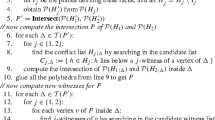Abstract
Given two intersecting polyhedraP, Q and a directiond, find the smallest translation ofQ alongd that renders the interiors ofP andQ disjoint. The same problem can also be posed without specifying the direction, in which case the minimum translation over all directions is sought. These are fundamental problems that arise in robotics and computer vision. We develop techniques for implicitly building and searching convolutions and apply them to derive efficient algorithms for these problems.
Similar content being viewed by others
References
P. Agarwal. Ray shooting and other applications of spanning trees with low stabbing number.Proc. 5th ACM Symposium on Computational Geometry, pp. 315–325, 1989.
A. Aggarwal, L. Guibas, J. Saxe, and P. Shor. A linear time algorithm for computing the Voronoi diagram of a convex polygon.Discrete and Computational Geometry, 4:591–604, 1989.
T. Asano. An efficient algorithm for finding the visibility polygons for a polygonal region with holes.Transactions of IECE of Japan, E-68:557–559, 1985.
B. S. Baker, S. F. Fortune, and S. R. Mahaney. Polygon containment under translation.Journal of Algorithms, 532–548, 1986.
J. Bentley and T. A. Ottman. Algorithms for reporting and counting geometric intersections.IEEE Transactions on Computers, 28:643–647, 1979.
C. E. Buckley and L. J. Leifer. A proximity metric for continuum path planning.Proc. 9th International Joint Conference on Artificial Intelligence, pp. 1096–1102, 1985.
S. A. Cameron and R. K. Culley. Determining the minimum translation distance between two convex polyhedra.Proc. IEEE International Conference on Robotics and Automation, pp. 591–596, 1986.
B. Chazelle. Efficient polygon triangulation.Proc. IEEE Symposium on Foundations of Computer Science, pp. 220–230, 1990.
B. Chazelle and D. Dobkin. Intersection of convex objects in two and three dimensions.Journal of the Association for Computing Machinery, 34:1–27, 1987.
F. Chin and C. A. Wang. Optimal algorithms for the intersection and the minimum distance problems between planar polygons.IEEE Transactions on Computers, 32:1203–1207, 1983.
D. Dobkin and D. Kirkpatrick. Fast detection of polyhedral intersections.Proc. ICALP '82, pp. 154–165. Lecture Notes in Computer Science, Vol. 140. Springer-Verlag, Berlin, 1982.
D. Dobkin and D. Kirkpatrick. A linear algorithm for determining the separation of convex polyhedra.Journal of Algorithms, 6:381–392, 1985.
D. Dobkin and D. Kirkpatrick. Determining the separation of preprocessed polyhedra—a unified approach.Proc. ICALP '90, pp. 400–413. Lecture Notes in Computer Science, Vol. 443. Springer-Verlag, Berlin, 1990.
H. Edelsbrunner. Computing the extreme distances between two convex polygons.Journal of Algorithms, 6:213–224, 1985.
H. Edelsbrunner, L. Guibas, and J. Stolfi. Optimal point location in a monotone subdivision.SIAM Journal on Computing, 15:317–340, 1986.
H. El Gindy and D. Avis. A linear algorithm for computing the visibility polygon from a point.Journal of Algorithms, 2:186–197, 1981.
M. Garey, D. S. Johnson, F. P. Preparata, and R. E. Tarjan. Triangulating a simple polygon.Information Processing Letters, 7:175–179, 1978.
B. Grünbaum.Convex Polytopes. Wiley, New York, 1967.
L. Guibas, M. Overmars, and M. Sharir. Intersecting line segments, ray shooting, and other applications of geometric partitioning techniques. InProc. First Scandinavian Workshop on Algorithm Theory, pp. 64–73. Lecture Notes in Computer Science, Vol. 318. Springer-Verlag, Berlin, 1988.
L. Guibas, L. Ramshaw, and J. Stolfi. A kinetic framework for computational geometry.Proc. 24th Foundations of Computer Science, pp. 100–111, Nov. 1983.
L. J. Guibas and J. Stolfi. Ruler, compass, and computer: The design and analysis of geometric algorithms. Research Report 37, DEC Systems Research Center, 1989. Also appeared inTheoretical Foundations of Computer Graphics and CAD, pp. 111–165, Springer-Verlag, New York.
J. Hershberger and L. Guibas. AnO(n2) shortest path algorithm for a nonrotating convex body.Journal of Algorithms, 9:18–46, 1988.
S. Hertel and K. Mehlhorn.Fast Triangulation of Simple Polygons, pp. 207–218. Lecture Notes in Computer Science, Vol. 158. Springer-Verlag, Berlin, 1983.
K. Kedem, R. Livne, J. Pach, and M. Sharir. On the union of Jordan regions and collision-free translational motion amidst polygonal obstacles.Discrete and Computational Geometry, 1:59–71, 1986.
S. S. Keerthi and K. Sridharan. Efficient algorithms for computing two measures of depth of collision between convex polygons. Technical Report, Department of Computer Science and Automation, IIS, Banglore, 1989.
D. Kirkpatrick. Optimal search in planar subdivisions.SIAM Journal on Computing, 12:28–35, 1983.
K. Mehlhorn.Multi-dimensional Searching and Computational Geometry. EATCS Monographs on Theoretical Computer Science. Springer-Verlag, Berlin, 1984.
T. A. Ottman, P. Widmeyer, and D. Wood. A fast algorithm for Boolean mask operations. Report No. 112, Institüt für Angewandte Mathematik und Formale Beschreibungsverfahren, W-7500 Karlsruhe, 1982.
F. P. Preparata and M. I. Shamos.Computational Geometry: An Introduction. Springer-Verlag, New York, 1985.
S. Suri and J. O'Rourke. Worst-case optimal algorithms for constructing visibility polygons with holes.Proc. 2nd ACM Symposium on Computational Geometry, pp. 14–23, 1986.
Author information
Authors and Affiliations
Additional information
Communicated by Takao Asano.
The work of this author was partially supported by National Science Foundation Grant CCR90-02352.
The work of this author was partially supported by Grant A3583 from the Natural Sciences and Engineering Research Council of Canada.
Rights and permissions
About this article
Cite this article
Dobkin, D., Hershberger, J., Kirkpatrick, D. et al. Computing the intersection-depth of polyhedra. Algorithmica 9, 518–533 (1993). https://doi.org/10.1007/BF01190153
Received:
Revised:
Issue Date:
DOI: https://doi.org/10.1007/BF01190153




